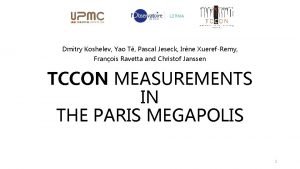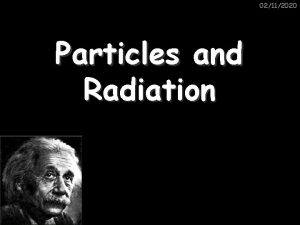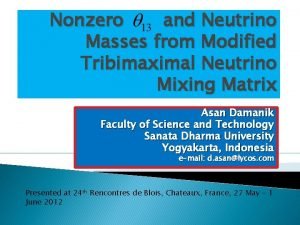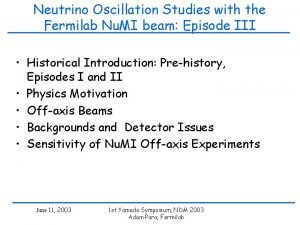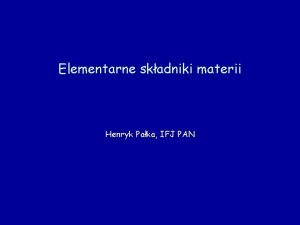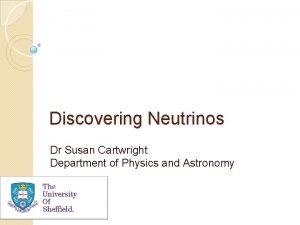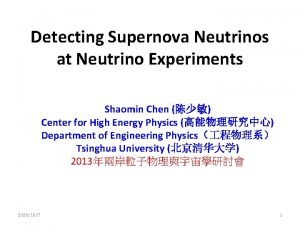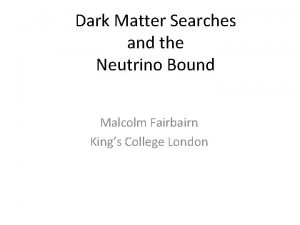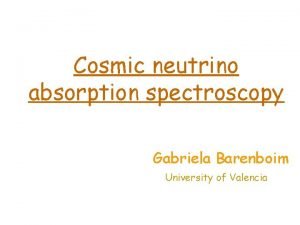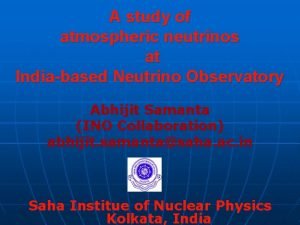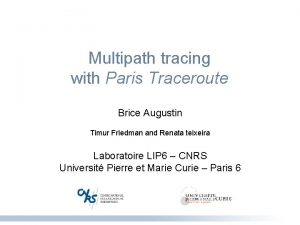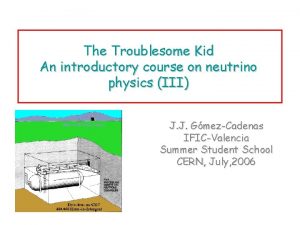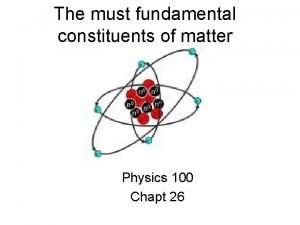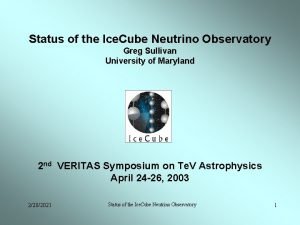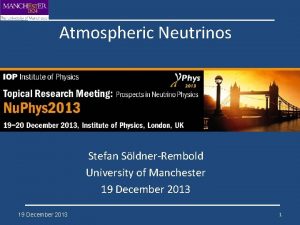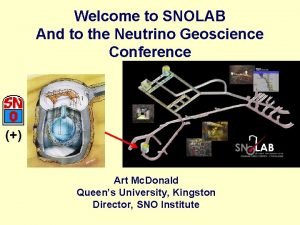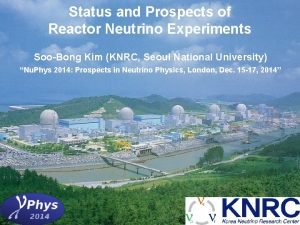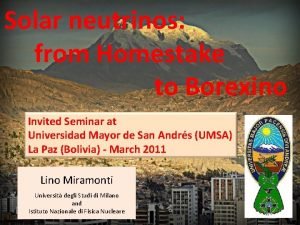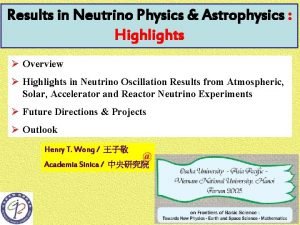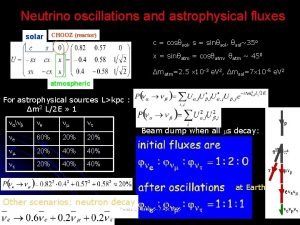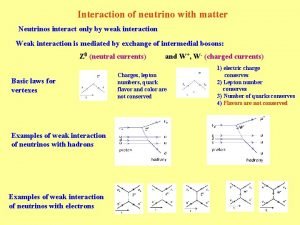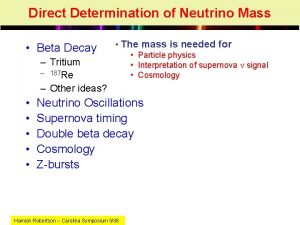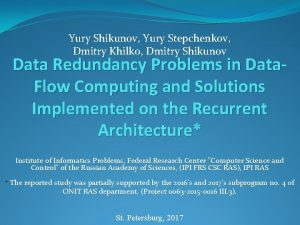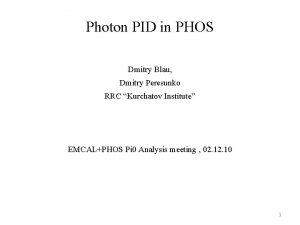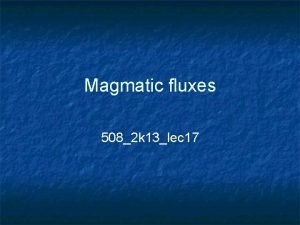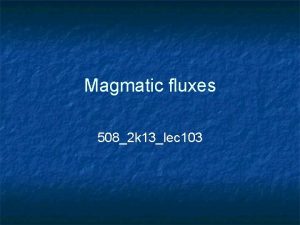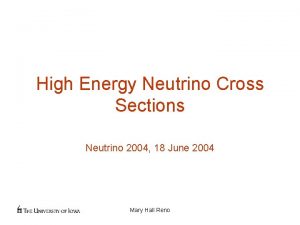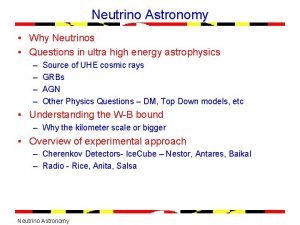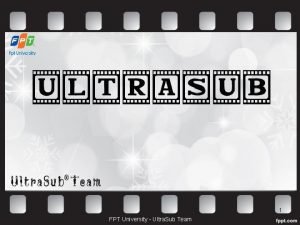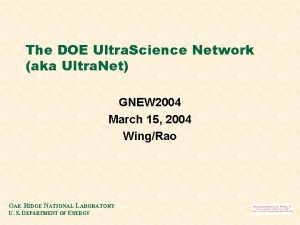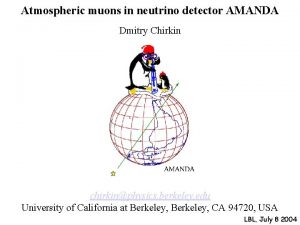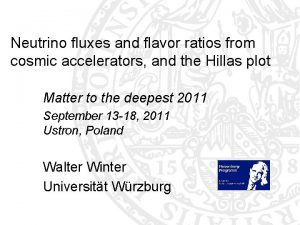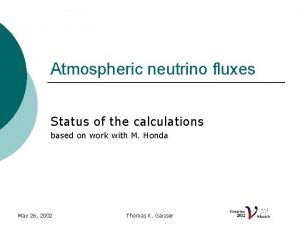Predictions of Ultra High Energy Neutrino fluxes Dmitry












































- Slides: 44

Predictions of Ultra - High Energy Neutrino fluxes Dmitry Semikoz APC Paris

Toulon April 24, 2008 Overview: Introduction: high energy neutrinos n Neutrinos from UHECR protons, diffused neutrino flux n Neutrinos from astrophysical sources n Conclusion n

Toulon April 24, 2008 INTRODUCTION

Toulon April 24, 2008 n's in AMANDA-II 1 Te. V

Toulon April 24, 2008 Why UHE neutrinos can exist? n n Protons are attractive candidates to be accelerated in astrophysical objects up to highest energies E~1020 e. V. Neutrinos can be produced by protons in P+P -> pions or P+ -> pions reactions inside of astrophysical objects or in intergalactic space. Neutrinos are produced by neutron decays: nuclei, proton-neutron conversion on CMB Neutrinos can be produced by protons or nuclei during propagation.

Toulon April 24, 2008 Pion production n p Conclusion: proton, photon and neutrino fluxes are connected in well-defined way. If we know one of them we can predict other ones:

Toulon April 24, 2008 Photons cascade down to low energies

Toulon April 24, 2008 Neutrinos from UHECR protons

Toulon April 24, 2008 The Greisen-Zatsepin-Kuzmin (GZK) effect Nucleons can produce pions on the cosmic microwave background nucleon pair production energy loss -resonance pion production energy loss multi-pion production rate Þsources must be in cosmological backyard within 50 -100 Mpc from Earth (compare to the Universe size ~ 5000 Mpc)

Toulon April 24, 2008 Hi. Res: cutoff in the spectrum “GZK” Statistics 3 9 2 1 • Expect 42. 8 events • Observe 15 events • ~5 s Bergman (ICRC-2005)

Toulon April 24, 2008 Auger Energy Spectrum 2007 6 s ---------------------

Toulon April 24, 2008 Mixed composition model: less neutrinos due to nuclei D. Allard, E. Parizot and A. Olinto, astro-ph/0512345 problem: escape of the nuclei from the source; galactic Fe?

Toulon April 24, 2008 Protons can fit UHECR data: minimal model V. Berezinsky , astro-ph/0509069 problem: composition

Toulon April 24, 2008

Toulon April 24, 2008 Photo-pion production n p

Toulon April 24, 2008 Parameters which define diffuse neutrino flux n Proton spectrum from one source: n Distribution of maximum energy of sources: n Distribution of sources:

Toulon April 24, 2008 Theoretical predictions of neutrino fluxes n n n WB bound: 1/E 2 protons; distribution of sources – AGN; analytical calculation of one point near 1019 e. V. MPR bound: 1/E protons; distribution of sources – AGN; numerical calculation for dependence on Emax The -ray bound: EGRET

Toulon April 24, 2008 Parameter degeneration G. Gelmini, O. Kalashev and D. S. , astro-ph/0702464

Toulon April 24, 2008 EGRET: diffuse gamma-ray flux The high energy gamma ray detector on the Compton Gamma Ray Observatory (20 Me. V - ~20 Ge. V)

Toulon April 24, 2008 Contribution of UHECR to EGRET GLAST ---------------------------------------- O. Kalashev , D. S. and G. Sigl, astro-ph/0704. 2463

Toulon April 24, 2008 Contribution UHECR to EGRET diffuse background for different a and m. --------------------------------------------------

Toulon April 24, 2008 Low flux of neutrino Z. Fodor et al, hep-ph/0309171

Toulon April 24, 2008 Future detection of neutrinos from UHECR protons (2002) AGN, 1/E / EUSO Old sources 1/E^2

Toulon April 24, 2008 Auger tau-neutrino limit 2007

Toulon April 24, 2008 Summary GZK neutrinos There is low bound E^2 F(E) > 0. 3 e. V/cm^2/s/sr n One need in “good” energy resolution to figure out the shape of the flux n One do not need in angular resolution n Search for individual sources at highest energies is hopeless n

Toulon April 24, 2008 Neutrinos from astrophysical sources

Toulon April 24, 2008 Te. V gamma-sources Pulsars and PWN SNRs GRBs AGNs

Toulon April 24, 2008 Problem I with Te. V sources n In order Te. V blazars be a neutrino sources: = sp n R>>1 t = s n R <<1 sp = 6 x 10 -28 cm 2 while s = 6. 65 x 10 -25 cm 2 t n n CONTRADICTION!!! Way out – production at different place/time or in p-p reactions.

Toulon April 24, 2008 Problem II with Te. V sources n n n Any part of Te. V gamma’s can be produced by electrons One need to explain all low energy emission radio-to-X-ray in hadronic models: usually requires to introduce electrons anyway. For individual source one can spread energy in gamma-rays on larger angle –neutrino flux can be enhanced. Price – few neutrino sources as compared to gamma-rays

Toulon April 24, 2008 Neutrino production in AGN core A. Neronov & D. S. , hep-ph/0208248

Toulon April 24, 2008 Example 1: blazars. Photon background in AGN core Energy scale E = 0. 1 – 10 e. V n Time variability t ~ few days or R = 1016 cm n Model: hot thermal radiation. n T=1 e. V T=10 e. V

Toulon April 24, 2008 Photo-pion production n p

Toulon April 24, 2008 Neutrino spectrum for various proton spectra and backgrounds Atm. flux 1/E E~1018 e. V 1/E 2 AMANDA II T=10 e. V 1/E 2 ANTARES T=1 e. V

Toulon April 24, 2008 Example 2: Variable Te. V emission from binary LS I +61 303 Ten points at equal phase intervals from F = 0 to F = 0. 9, with MAGIC observations (where available) on the right. The periastron is at F = 0. 2. MAGIC Collaboration, Science 312: 1771 -1773, 2006 F=(2. 7+-0. 4+-0. 8)*10 -12 /cm 2/s/Te. V.

Toulon April 24, 2008 Electromagnetic model of binary LS I +61 303 Zdziarski et al, ar. Xiv: 0802. 1174

Toulon April 24, 2008 Neutrino emission from p+p process Diego F. Torres, Francis Halzen , Astropart. Phys. 27: 500 -508, 2007. If F_nu=F_gamma 0. 3 -0. 7 events /2. 5 background /year

Toulon April 24, 2008 Other galactic sources Galactic cosmic rays (talk by A. Taylor) n Milagro sources (talk by A. Kappes) n

Toulon April 24, 2008 Summary neutrinos from point sources n n P-P reaction can give a hope to follow galactic Te. V sources (example: binary systems) GLAST: May 2008! Galactic and extragalactic candidates at multi-Ge. V! One need in “as good as possible” angular resolution to suppress background AND to find out which source is real one. It would be nice to have good energy resolution.

Toulon April 24, 2008 Neutrinos from Galactic Supernova

Toulon April 24, 2008 Possible neutrino signals from Galactic SN in km^3 detector Prompt neutrino signal in 1 -50 Me. V energies. 1 -10 sec after SN burst/Strong signal in each optical module / SN 1987 A signal 50 -200 events with E> 1 Te. V in 10 -12 hours after burst. Shock front reached surface and became colisionless. Duration t ~ 1 hour / Waxman & Loeb 2001 SN shock interact with pre-SN wind and interstelar medium. 1000 -10000 events with E>1 Te. V in km^3 detector From 10 days till 1 year /Berezinsky & Ptuskin 1989

Toulon April 24, 2008 Supernova Monitor Amanda-II B 10: 60% of Galaxy A-II: 95% of Galaxy Amanda-B 10 Count rates 0 5 Ice. Cube: up to LMC 10 sec Ice. Cube

Toulon April 24, 2008 Pointing to Galactic SN n n n AMANDA II can see 5 -20 events with E> 1 Te. V. For AMANDA II angular resolution 2 o of each event. Pointing to SN direction is possible with resolution ~0. 5 o For ANTARES pointing is up to 0. 1 o. Compare to Super. Kamiokande 8 o now and 3. 5 o with gadolinium. Hyper. Kamiokande ~0. 6 o

Toulon April 24, 2008 Detection of Galactic SN from ‘wrong side’ by km^3 detector n Atmospheric muons 5*1010/year or 300/hour/(1 o)2 n Signal 200 events, besides energy cut 1 Te. V. Angular resolution 0. 8 o for each event or less then 0. 1 o for SN signal !!! n (A. Digle, M. Kachelriess, G. Raffelt, D. S. and R. Tomas, hep-ph/0307050)

Toulon n April 24, 2008 Conclusions All top-down and exotic models are not needed anymore for UHECR data. Bad news for neutrinos: no high fluxes at high energies. Secondary neutrino flux from UHECR protons can be detected by km^3 experiments. Situation will clear up in 1 -2 years after input of GLAST and new results from AUGER. Neutrino flux from different kind of astrophysical sources can be detected by km^3 neutrino telescopes. However relation of neutrino fluxes to gamma-ray fluxes strongly model dependent.
 Dmitry zagryazhsky
Dmitry zagryazhsky Andre bliznyuk
Andre bliznyuk Dmitry shatilov
Dmitry shatilov Dmitry lyalin
Dmitry lyalin Dmitry koshelev
Dmitry koshelev Dmitri mendeleev facts
Dmitri mendeleev facts Future dmitry
Future dmitry Bell aliant high speed ultra
Bell aliant high speed ultra Dotterkärna
Dotterkärna The leptons
The leptons Emission spectrum of sodium
Emission spectrum of sodium Neutrino
Neutrino Neutrino
Neutrino Lekka cząstka elementarna mion elektron lub neutrino
Lekka cząstka elementarna mion elektron lub neutrino Who discovered neutrino
Who discovered neutrino Neutrino
Neutrino Neutrino
Neutrino Neutrino density
Neutrino density Neutrino
Neutrino Paris traceroute
Paris traceroute Neutrino
Neutrino Neutrino symbol
Neutrino symbol Neutrino
Neutrino Neutrino
Neutrino Solar neutrino
Solar neutrino Neutrino
Neutrino Solar neutrino
Solar neutrino Solar neutrino
Solar neutrino Neutrino mass
Neutrino mass Neutrino
Neutrino Neutrino interaction with matter
Neutrino interaction with matter Neutrino mass
Neutrino mass Energy energy transfer and general energy analysis
Energy energy transfer and general energy analysis Energy energy transfer and general energy analysis
Energy energy transfer and general energy analysis Will/won't/may/might for predictions
Will/won't/may/might for predictions Names from romeo and juliet
Names from romeo and juliet Prediction vs inference venn diagram
Prediction vs inference venn diagram Good readers making prediction by
Good readers making prediction by Making predictions powerpoint
Making predictions powerpoint How to make a prediction on a scatter plot
How to make a prediction on a scatter plot Making predictions with experimental probability
Making predictions with experimental probability Assumptions generalizations predictions vs. conclusion
Assumptions generalizations predictions vs. conclusion The future simple predictions
The future simple predictions Making predictions practice
Making predictions practice Can you make predictions about tech devices
Can you make predictions about tech devices




